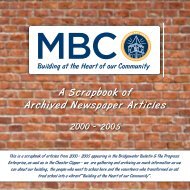Create successful ePaper yourself
Turn your PDF publications into a flip-book with our unique Google optimized e-Paper software.
The Strap <strong>and</strong> Detention Miss Dukeshire Loses Her Cool<br />
Discipline was rough <strong>and</strong> ready in the early decades of the school’s history.<br />
• Physical punishment-a slap or grabbed by the collar or scruff of the neckwas<br />
common. Some teachers, like the mighty Flo Mullock, had a reputation<br />
for it. She could also shake a desk to “rattle your bones” says Earle Langille.<br />
So was acceptance of such treatment. The Hirtle children of Warren [mayor<br />
<strong>and</strong> school board chair] <strong>and</strong> his very caring wife, knew they would be summoned<br />
to the porch, by mum, for the strap if they got out of line.<br />
•The strap was used regularly- “Too much!” [in the words of Hope Hyson].<br />
Philip Lohnes, the future mayor of <strong>Mahone</strong> <strong>Bay</strong> had been strapped on his<br />
first day of school in 1923, when, as a primary student, he followed his sisters<br />
through the girls only entrance. Students might be strapped for not having<br />
work done. Mary Elizabeth Kedy[Smith] remembered being strapped for<br />
not putting her h<strong>and</strong> up before approaching the teacher’s desk.<br />
• There is one extreme story recorded in the minutes of the <strong>School</strong> Board.<br />
Gladys Dukeshire, from Caledonia, was vice-principal for one year 1925-26.<br />
The minutes record an extraordinary complaint <strong>and</strong> explanation at its April<br />
23rd, 1926 meeting. Mr. Davis was present about a complaint that his son,<br />
Llewelyn, had been strapped on the h<strong>and</strong>s, back <strong>and</strong> face by Miss Dukeshire,<br />
who had also told the boy that he behaved like “a cannibal” <strong>and</strong> that she<br />
would not teach him again.<br />
• Miss Dukeshire offered the following explanation, copied verbatim from<br />
the minutes: The boy admitted throwing a board duster that [accidently]<br />
broke a window. He had not tried to eat anybody:<br />
You see my size <strong>and</strong> the boy’s: consider for yourself-am I capable of inflicting the<br />
punishment Mr. Davis would have you believe I did?<br />
I strapped him eight times on one h<strong>and</strong>, but when asked to hold out the other h<strong>and</strong>,<br />
he refused. I then hit him, not over half a dozen times, on the back.<br />
I consider Llewelyn a very poor pupil <strong>and</strong> disobedient. I have stayed after school<br />
with him on a number of occasions to help him, <strong>and</strong> have done my best.<br />
Today, in the new century, the teacher would have been suspended immediately,<br />
until a full investigation, <strong>and</strong> would almost certainly not have taught<br />
again. In 1925 no apologies were recorded, but Miss Dukeshire agreed to continue<br />
to teach the boy. The minutes actually record Mr. Davis saying, “….he<br />
was not complaining so much against the punishment as the refusal to teach the<br />
child.’<br />
In the 1930s H.V. Corkum insisted teachers record all administration of the<br />
strap, then, later collected all the straps <strong>and</strong> administered the strapping himself.<br />
This was very much the situation until the early 1980s when the new<br />
South Shore District Board banned the strap <strong>and</strong> all corporal punishment.<br />
Report Cards <strong>and</strong> Teachers<br />
Courtesy: Earle Langille Collection<br />
In September 1923, the Board passed a motion: We procure one thous<strong>and</strong><br />
“report cards.” The quotation marks are the secretary’s <strong>and</strong>, no doubt, were<br />
used to illustrate the novelty of the idea <strong>and</strong> the item. This writer assumes<br />
principal Langille should be given credit for the introduction of what is now<br />
commonplace.<br />
• Report Cards were a 1920s innovation. And they were exactly that: a<br />
printed card that could be filled out both sides by the teacher. They reflect<br />
the marks-tests-exams-pass-fail focus of the time. They were signed by the<br />
teacher, sent out <strong>and</strong> returned [signed by a parent] at the end of each term. A<br />
grading certificate was issued at the end of the year.<br />
Earle Langille’s mother must have been proud of him. She kept every report<br />
card. His marks <strong>and</strong> behaviour were good, <strong>and</strong>, appropriately he went on to<br />
be a classroom teacher, school principal [he opened the new Hebbville Junior-Senior<br />
High in [1960], Municipality of Lunenburg sub-system supervisor,<br />
then assistant superintendent.]<br />
He ran down the aisle. I followed, <strong>and</strong> as I caught hold of him he stumbled <strong>and</strong> fell.<br />
I then hit him again over the back.<br />
84





